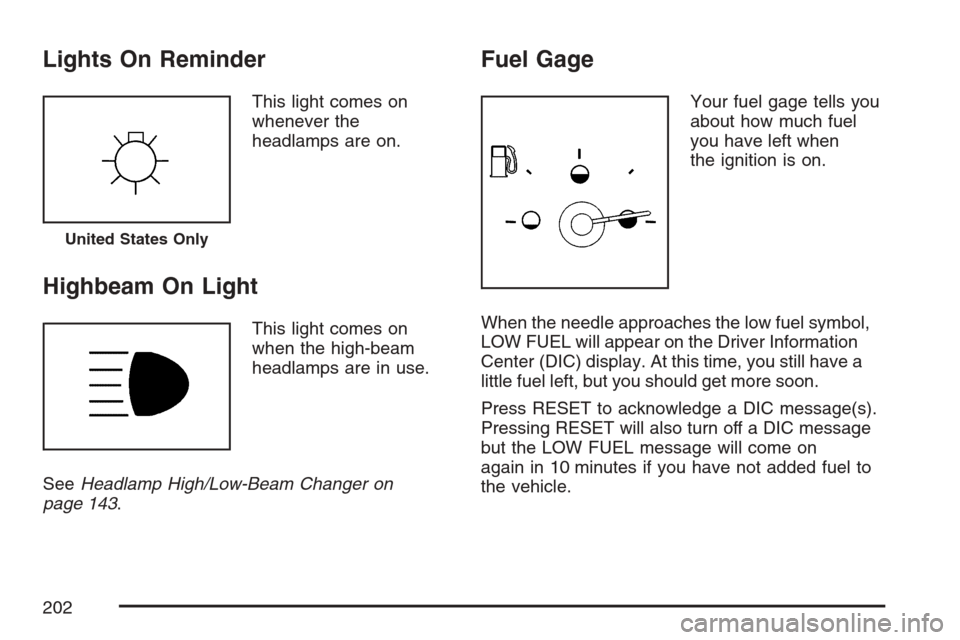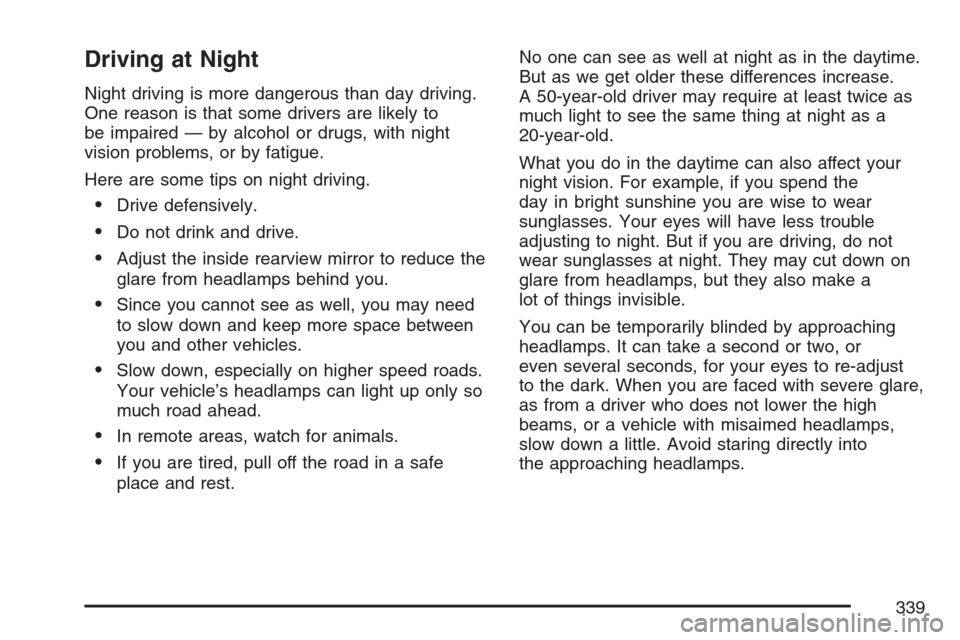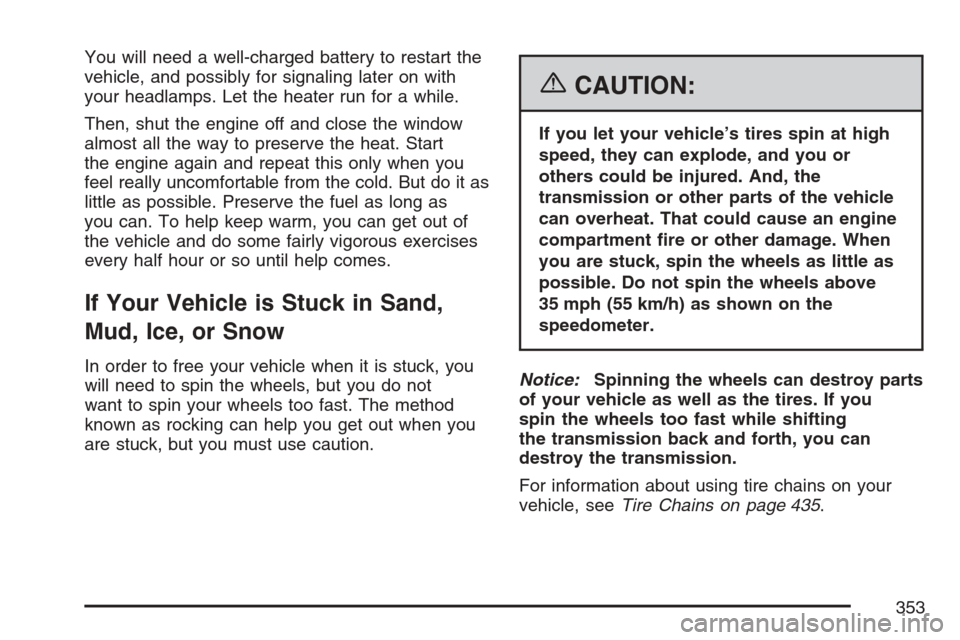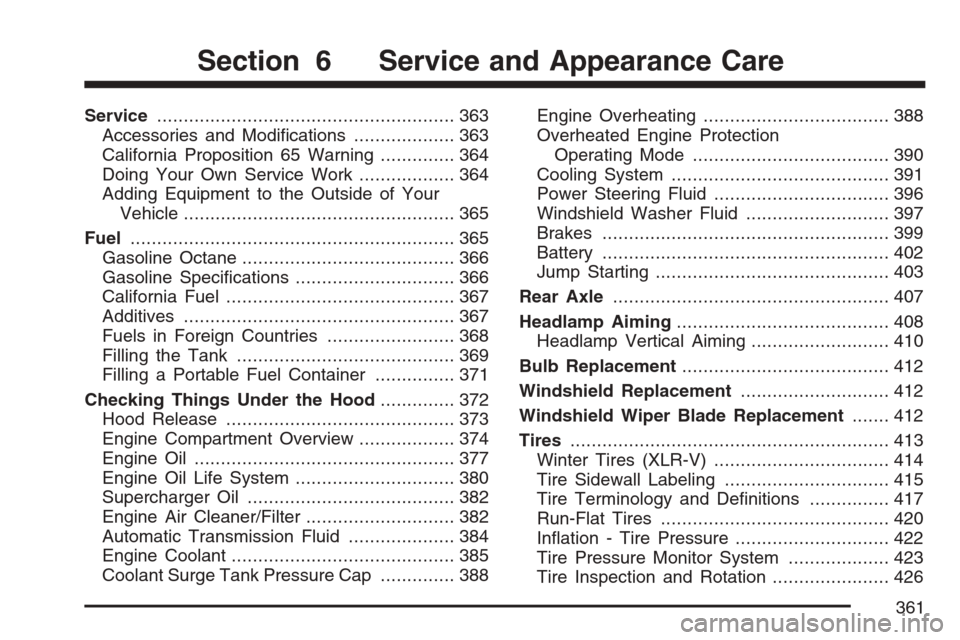headlamp CADILLAC XLR V 2007 1.G User Guide
[x] Cancel search | Manufacturer: CADILLAC, Model Year: 2007, Model line: XLR V, Model: CADILLAC XLR V 2007 1.GPages: 512, PDF Size: 3.84 MB
Page 169 of 512

During that delay, your instrument panel cluster
may not be as bright as usual. Make sure
your instrument panel brightness control is in full
bright position. SeeInstrument Panel Brightness
on page 170for more information.
You can idle the vehicle with the lamps off, even
when it is dark outside. After starting the
vehicle, turn the exterior lamp control band to off,
then release it. The lamps will remain off until
you turn the control band to off again.
Twilight Sentinel
®also provides exterior
illumination as you leave the vehicle. If Twilight
Sentinel
®has turned on the lamps when you turn
off the ignition, your lamps will remain on until:
The exterior lamp switch is moved from OFF to
the parking lamp position, or
a delay time that you select has elapsed.
SeeDriver Information Center (DIC) on page 203
to select the delay time that you want. You
can also select no delay time.If you turn off the ignition with the exterior lamp
switch in the parking lamp or headlamp position, the
Twilight Sentinel
®delay will not occur. The lamps
will turn off as soon as the switch is turned off.
As with any vehicle, you should turn on the regular
headlamp system when you need it.
Exterior Lighting Battery Saver
If the manual parking lamps or headlamps have
been left on, the exterior lamps will turn off as soon
as the ignition is turned off or RAP is active.
This protects against draining the battery in case
you have accidentally left the headlamps or
parking lamps on. The battery saver does not work
if the headlamps are turned on after the ignition
switch is turned to off.
If you need to leave the lamps on, use the exterior
lamp control to turn the lamps back on.
169
Page 202 of 512

Lights On Reminder
This light comes on
whenever the
headlamps are on.
Highbeam On Light
This light comes on
when the high-beam
headlamps are in use.
SeeHeadlamp High/Low-Beam Changer on
page 143.
Fuel Gage
Your fuel gage tells you
about how much fuel
you have left when
the ignition is on.
When the needle approaches the low fuel symbol,
LOW FUEL will appear on the Driver Information
Center (DIC) display. At this time, you still have a
little fuel left, but you should get more soon.
Press RESET to acknowledge a DIC message(s).
Pressing RESET will also turn off a DIC message
but the LOW FUEL message will come on
again in 10 minutes if you have not added fuel to
the vehicle.
United States Only
202
Page 209 of 512

ENGINE PROTECTION REDUCE
ENGINE RPM
If this message displays, the control system has
determined that continued operation at the existing
engine speed may lead to engine overheating.
Lower the engine speed by upshifting the
transmission or drive at a lower speed.
HEADLAMPS SUGGESTED
This message displays if it is dark enough outside
and the headlamps and Twilight Sentinel®
controls are off. This message informs the driver
that turning on the exterior lamps is recommended.
It has become dark enough outside to require
the headlamps and/or other exterior lamps. This
message also displays if the optional Rainsense™
wiping feature is on and the Twilight Sentinel
®
is off.
HIGH TRANS (Transmission) TEMP
(Temperature)
This message displays when the transmission �uid
in your vehicle is too hot. Stop and allow your
vehicle to idle until it cools down or until this
message is removed.
HIGH VOLTAGE
This message displays when the electrical
charging system is overcharging. To avoid being
stranded, have the electrical system checked
by your dealer. You can reduce the charging
overload by using the accessories. Turn on the
lamps and radio, set the climate control on AUTO
and the fan speed on HI, and turn the rear
window defogger on. You can monitor battery
voltage on the DIC by pressing the information
button. The normal range is 11.5 to 15.5 volts
when the engine is running.
HOT ENGINE–A/C OFF
This message displays when the engine coolant
becomes hotter than the normal operating
temperature. You can continue to drive your
vehicle. If this message continues to display, have
the system repaired by your dealer as soon as
possible to avoid compressor damage.
ICE POSSIBLE
This message displays when the outside air
temperature is cold enough to create icy road
conditions. Adjust your driving accordingly.
209
Page 220 of 512

DIC Vehicle Personalization
Your vehicle has personalization capabilities that
allow you to program certain features to a
preferred setting for up to two drivers. The back of
the keyless access transmitters are labelled 1 or 2.
The current driver’s preferences are recalled
when one of the following occurs:
The lock or unlock button on the keyless
access transmitter, programmed as 1 or 2, is
pressed.
The appropriate memory button, 1 or 2,
located on the driver’s seat is pressed.
SeeMemory Seat, Mirrors and Steering Wheel
on page 10for more information.
A valid keyless access transmitter is detected
upon opening the driver’s door.
If more than one valid keyless access transmitter
is detected upon opening the driver’s door, the
driver preferences for the lowest driver number will
be recalled.
If a keyless access transmitter is programmed
as #3 or #4, the personalization system will
not recognize the transmitter. The Driver
Information Center (DIC) will not display a currentdriver number and the features that are normally
programmed through the DIC will be set to
the default states. Also, if the OPTIONS button is
pressed, the DIC does not display the menus
used to set personalizations, but instead displays
OPTIONS UNAVAILABLE for a few seconds.
Feature Programming
To change feature preferences, make sure the
vehicle is running and in PARK (P). To avoid
excessive drain on the battery, it is recommended
that the headlamps are turned off. Press the
OPTIONS button and the Driver Information Center
(DIC) will display the current driver for a few
seconds, then display the �rst personalization
menu item. You can now use the OPTIONS button
to change the setting of the displayed feature.
Press the top or bottom of the information button
to scroll up or down the list of features. When
you get to a feature you want to change, press the
OPTIONS button again. When you are �nished,
press the RESET button to exit the personalization
menu. If no button is pressed within 45 seconds,
the DIC will exit the personalization menu.
The following are DIC options that will be available
in the personalization menu.
220
Page 221 of 512

Auto Recall
This feature allows the steering column, outside
mirrors and the driver’s seat to automatically move
to the current driver’s set position when the
engine starts. The DIC will display AUTO RECALL
OFF or AUTO RECALL ON. Press the OPTIONS
button to change the setting.
Auto Exit Recall
This feature allows the steering column and
driver’s seat to automatically move to the current
driver’s exit position when one of the following
occurs:
The vehicle is turned off or in RAP or
accessory mode and the driver’s door
is opened.
The vehicle is turned off or in RAP and the
unlock button on the keyless access
transmitter is pressed.
The DIC will display AUTO EXIT RECALL OFF or
AUTO EXIT RECALL ON. Press the OPTIONS
button to change the setting.
Approach Lights
This feature activates the parking lamps, front fog
lamps and back-up lamps during low light periods
when the unlock button on the keyless access
transmitter is pressed, both doors are closed and
the vehicle is off or in RAP. The lamps remain on for
20 seconds or until a door is opened, the lock
button on the keyless access transmitter is pressed
or the vehicle is no longer off or in RAP.
The DIC will display APPROACH LIGHTS OFF or
APPROACH LIGHTS ON. Press the OPTIONS
button to change the setting.
Exit Lights
This feature activates the parking lamps and front
fog lamps for 15, 30 or 90 seconds. This will
occur when the vehicle is off or in RAP and the
headlamps are on due to the automatic headlamp
system. The parking lamps and front fog lamps
will remain on until the driver selected time period
expires, the exterior lamp control is activated or
the vehicle is no longer off or in RAP.
The DIC will display EXIT LIGHTS OFF, EXIT
LIGHTS - 15 SEC, EXIT LIGHTS - 30 SEC,
or EXIT LIGHTS - 90 SEC. Press the OPTIONS
button to change the setting.
221
Page 339 of 512

Driving at Night
Night driving is more dangerous than day driving.
One reason is that some drivers are likely to
be impaired — by alcohol or drugs, with night
vision problems, or by fatigue.
Here are some tips on night driving.
Drive defensively.
Do not drink and drive.
Adjust the inside rearview mirror to reduce the
glare from headlamps behind you.
Since you cannot see as well, you may need
to slow down and keep more space between
you and other vehicles.
Slow down, especially on higher speed roads.
Your vehicle’s headlamps can light up only so
much road ahead.
In remote areas, watch for animals.
If you are tired, pull off the road in a safe
place and rest.No one can see as well at night as in the daytime.
But as we get older these differences increase.
A 50-year-old driver may require at least twice as
much light to see the same thing at night as a
20-year-old.
What you do in the daytime can also affect your
night vision. For example, if you spend the
day in bright sunshine you are wise to wear
sunglasses. Your eyes will have less trouble
adjusting to night. But if you are driving, do not
wear sunglasses at night. They may cut down on
glare from headlamps, but they also make a
lot of things invisible.
You can be temporarily blinded by approaching
headlamps. It can take a second or two, or
even several seconds, for your eyes to re-adjust
to the dark. When you are faced with severe glare,
as from a driver who does not lower the high
beams, or a vehicle with misaimed headlamps,
slow down a little. Avoid staring directly into
the approaching headlamps.
339
Page 340 of 512

Keep the windshield and all the glass on your
vehicle clean — inside and out. Glare at night is
made much worse by dirt on the glass. Even
the inside of the glass can build up a �lm caused
by dust. Dirty glass makes lights dazzle and
�ash more than clean glass would, making the
pupils of your eyes contract repeatedly.
Remember that the headlamps light up far less of a
roadway when you are in a turn or curve. Keep your
eyes moving; that way, it is easier to pick out dimly
lighted objects. Just as the headlamps should be
checked regularly for proper aim, so should your
eyes be examined regularly. Some drivers suffer
from night blindness — the inability to see in dim
light — and are not even aware of it.Driving in Rain and on Wet Roads
Rain and wet roads can mean driving trouble. On a
wet road, you cannot stop, accelerate, or turn as
well because your tire-to-road traction is not as
good as on dry roads. And, if your tires do not have
much tread left, you will get even less traction. It is
always wise to go slower and be cautious if rain
starts to fall while you are driving. The surface may
get wet suddenly when your re�exes are tuned for
driving on dry pavement.
340
Page 353 of 512

You will need a well-charged battery to restart the
vehicle, and possibly for signaling later on with
your headlamps. Let the heater run for a while.
Then, shut the engine off and close the window
almost all the way to preserve the heat. Start
the engine again and repeat this only when you
feel really uncomfortable from the cold. But do it as
little as possible. Preserve the fuel as long as
you can. To help keep warm, you can get out of
the vehicle and do some fairly vigorous exercises
every half hour or so until help comes.
If Your Vehicle is Stuck in Sand,
Mud, Ice, or Snow
In order to free your vehicle when it is stuck, you
will need to spin the wheels, but you do not
want to spin your wheels too fast. The method
known as rocking can help you get out when you
are stuck, but you must use caution.
{CAUTION:
If you let your vehicle’s tires spin at high
speed, they can explode, and you or
others could be injured. And, the
transmission or other parts of the vehicle
can overheat. That could cause an engine
compartment �re or other damage. When
you are stuck, spin the wheels as little as
possible. Do not spin the wheels above
35 mph (55 km/h) as shown on the
speedometer.
Notice:Spinning the wheels can destroy parts
of your vehicle as well as the tires. If you
spin the wheels too fast while shifting
the transmission back and forth, you can
destroy the transmission.
For information about using tire chains on your
vehicle, seeTire Chains on page 435.
353
Page 361 of 512

Service........................................................ 363
Accessories and Modi�cations................... 363
California Proposition 65 Warning.............. 364
Doing Your Own Service Work.................. 364
Adding Equipment to the Outside of Your
Vehicle................................................... 365
Fuel............................................................. 365
Gasoline Octane........................................ 366
Gasoline Speci�cations.............................. 366
California Fuel........................................... 367
Additives................................................... 367
Fuels in Foreign Countries........................ 368
Filling the Tank......................................... 369
Filling a Portable Fuel Container............... 371
Checking Things Under the Hood.............. 372
Hood Release........................................... 373
Engine Compartment Overview.................. 374
Engine Oil................................................. 377
Engine Oil Life System.............................. 380
Supercharger Oil....................................... 382
Engine Air Cleaner/Filter............................ 382
Automatic Transmission Fluid.................... 384
Engine Coolant.......................................... 385
Coolant Surge Tank Pressure Cap.............. 388Engine Overheating................................... 388
Overheated Engine Protection
Operating Mode..................................... 390
Cooling System......................................... 391
Power Steering Fluid ................................. 396
Windshield Washer Fluid........................... 397
Brakes...................................................... 399
Battery...................................................... 402
Jump Starting............................................ 403
Rear Axle.................................................... 407
Headlamp Aiming........................................ 408
Headlamp Vertical Aiming.......................... 410
Bulb Replacement....................................... 412
Windshield Replacement............................ 412
Windshield Wiper Blade Replacement....... 412
Tires............................................................ 413
Winter Tires (XLR-V) ................................. 414
Tire Sidewall Labeling............................... 415
Tire Terminology and De�nitions............... 417
Run-Flat Tires........................................... 420
In�ation - Tire Pressure............................. 422
Tire Pressure Monitor System................... 423
Tire Inspection and Rotation...................... 426
Section 6 Service and Appearance Care
361
Page 408 of 512

What to Use
To add lubricant when the level is low, use
SAE 75W–90 Synthetic Gear Lubricant
(GM Part No. 89021677) or equivalent meeting
GM Speci�cation 9986115. To completely
re�ll after draining, add 4 ounces (118 ml) of
Limited-Slip Differential Lubricant Additive
(GM Part No. 1052358) or equivalent. Then �ll to
the bottom of the �ller plug hole with the
Synthetic Gear Lubricant.
Headlamp Aiming
Your vehicle has high intensity discharge (HID)
visual optical aiming type headlamps. The aim has
been preset at the factory and should need no
further adjustment. If you suspect that the
headlamps need to be reaimed, it is recommended
that you contact your dealer for service. However,
it is possible for you to re-aim your headlamps
as described in the following procedure.
Notice:To make sure your headlamps are
aimed properly, read all the instructions before
beginning. Failure to follow these instructions
could cause damage to headlamp parts.
408